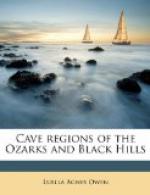Those persons who have been so unfortunate as to permit themselves to accept a ready made opinion of dangers and roughness to be met with in the more newly settled regions, might find a tour of the Hills doubly interesting by making a supplementary study of “The Living Age,” which cannot be so correctly viewed from a distance as is sometimes supposed, since the specimens exhibited are not always a true average of the strata they are supposed to represent.
CHAPTER XVI.
Conclusion.
After a visit to the marvelous caverns of the Black Hills, much may be added to the pleasure already enjoyed, through the explanatory activity of the Yellowstone National Park, where even the wonderful combinations of beauty and grandeur are by no means the full measure of attraction and charm. Here is found evidence to verify theories concerning the caves, and those theories in turn contribute in no small degree to a satisfactory understanding of the mysteries of geyser action. For scientific study the two regions should be taken together, since the natural conditions are practically the same, and the chief difference lies in the stages of development; the present of the Park explaining the recent past of the Hills, while the present of the Hills foretells the future of the Park. It seems that Nature, with a full appreciation of the limits and restrictions binding our powers to penetrate certain secrets of an intermittent force, has in this great western country carefully prepared what might quite properly be termed a progressive course of study, wherein each locality makes plain a special point that somewhere else appears obscure.
As has been said in the preceding chapters, the two great caves in the Black Hills of South Dakota cannot be accounted for by the same methods as are recognized as being responsible for the slow excavation of the best known caves of the United States. Although there is every indication that both these caves have been subject to the action of enormous volumes of water, there is equally positive evidence that neither was ever the scene of a flowing cave-river. The lowest levels in both show the narrowest fissures and the heaviest deposits of crystal, by which we infer that the water was held in confinement here, while all the higher passages or channels bear witness to the water’s flow. But many of these channels in Crystal Cave, or indeed we might say, most of them, present an unmistakable record of the gauge of the water stage at different periods. During the earlier time, when the volume of water and consequent pressure were greatest, frictional motion must have been limited to the main channel connecting with the vent, and the high gauge of water maintained a fairly uniform degree of heat near its surface. In consequence of these conditions geyser action, probably, was constant, and chemical activity was such that great chambers




